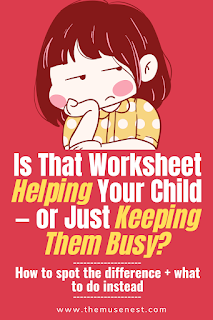How to Spot the Difference Between Meaningful Activities and Brain-Draining Busywork
“Look, she finished ten worksheets today!”
The pile of papers looked impressive—boxes ticked, lines traced, letters copied.
But when I asked my daughter what she remembered about any of them, she shrugged and said, “I dunno. I just did what it said.”
If you’ve ever found yourself wondering whether your child’s worksheets are actually teaching anything—or just passing time—you’re not imagining things.
Not all worksheets are created equal.
Some strengthen core skills. Others? Just keep little hands busy without engaging the brain—or the heart.
In this article, we’ll explore:
- How to tell the difference
- Why some kids tune out or resist worksheets
- What to look for in meaningful activities
- And how to gently shift from busywork to brain-building at home
🧠 What Is “Busywork,” Really?
Busywork refers to tasks that look productive but offer little actual learning value. These might include:
- Repetitive tracing with no variation or challenge
- Coloring within tight lines with no creative decision-making
- Endless cut-and-paste activities that don’t reinforce understanding
- Worksheets used simply to fill time rather than teach a concept
It’s not that these tasks are bad—some repetition is helpful!
But when used too often, without context, or without engagement… they become passive learning.
📌 Warning sign: If your child finishes quickly, remembers nothing, and shows no interest—it might be busywork.
🚫 Why Too Much Busywork Backfires
Children are naturally curious. But busywork can cause:
- Burnout from over-repetition
- Boredom that leads to resistance
- Low confidence (especially if they don’t “get” the task)
- Missed opportunities for real problem-solving, play, and connection
Busywork is often performance-driven—focused on compliance, not creativity.
The child becomes a box-ticker instead of a meaning-maker.
✅ What Makes an Activity “Meaningful”?
Not all worksheets are bad. In fact, when used intentionally, they can:
- Reinforce a concept just learned
- Provide scaffolding for a tricky skill
- Encourage independence
- Offer a sense of progress and mastery
The key difference? Engagement.
Ask yourself:
- Does this activity connect to something we’ve been talking about?
- Does it allow for choice, creativity, or critical thinking?
- Is it developmentally appropriate (not too easy, not too hard)?
- Does my child feel proud, curious, or interested while doing it?
If yes → you’re in meaningful territory.
🔍 Examples: Busywork vs. Brainwork
| Busywork | Brainwork |
|---|---|
| Tracing the letter “A” 20 times | Writing a word that starts with “A” and drawing a picture |
| Coloring a pre-drawn apple | Designing your own fruit with colors and naming it |
| Cut-paste sequence with no context | Sequencing steps for brushing teeth or baking cookies |
| Matching letters silently | Playing a matching game and explaining why each pair goes together |
| Counting identical shapes repeatedly | Sorting different objects and graphing them |
🧠 Same materials. Different purpose.
💡 How to Shift from Busywork to Purposeful Play
You don’t have to ditch worksheets completely.
But you can adapt your approach for deeper learning.
1. 📚 Pair Worksheets with Hands-On Activities
Learning about the letter “B”?
Do a worksheet after you’ve built a banana out of blocks, read a book about bears, and made “B” sounds with bubbles.
2. ✂️ Let Kids Create Their Own
Instead of handing them a cut-and-paste sheet, say:
“Can you make a worksheet for me?”
Kids love turning the tables. They think critically while designing—and you learn what they understand.
3. 🎨 Add Open-Ended Elements
If they finished tracing letters, ask:
“Can you write a silly sentence with those letters?”
“Can you draw a story that uses all those words?”
It bridges structure with imagination.
4. 🎲 Use Play-Based Alternatives
Many skills taught through worksheets can be practiced through:
- Sorting toys by color or size
- Making patterns with snacks
- Storytelling with figurines
- Letter hunts around the house
Same brain pathways—more joy.
❤️ Final Thoughts: It’s Not About the Paper — It’s About the Process
A worksheet isn’t bad. A printable isn’t pointless.
But when the goal becomes “just finish the page,” instead of “discover something new,” the learning gets lost.
As parents and educators, our job isn’t to pile up papers.
It’s to create opportunities—to connect, question, and build thinking minds.
So next time you’re printing out another activity, ask yourself:
“Is this helping my child grow—or just keeping them busy?”
If the answer is growth… you’re already on the right track.











0 Comments